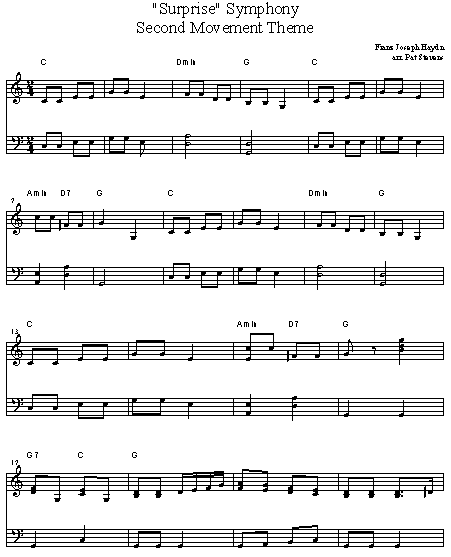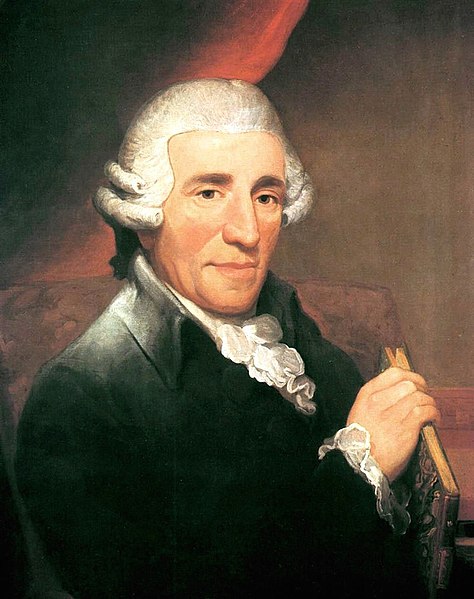"Loving a child doesn't mean giving in to all his whims;
to love him is to bring out the best in him,
to teach him to love what is difficult."
AUTHOR: Nadia Boulanger
MEANING OF THE QUOTE:
"The greatest gift of love you can give a child is to teach him/her
how to love the challenge of achieving personal goals."
SURPRISE
SYMPHONY NO. 94
in G MAJOR HOB I:94
"SURPRISE" (1791)
Complete
Leonard Bernstein, Conductor
Wiener Philarmoniker
4. Finale: Allegro molto



The "Surprise" Symphony was one of six
Haydn composed for his immensely successful
residency while in London from 1791-1792
Haydn said that the effect was meant
"to surprise the public with something new,
and to make a debut in a brilliant manner"
"critical applause was fervid and
abundant" at the Symphony’s premiere
| Surprise 4th Movement: Main Theme |



The "Surprise" Symphony was one of six
Haydn composed for his immensely successful
residency while in London from 1791-1792
 |
| London during Haydn's Time |
"to surprise the public with something new,
and to make a debut in a brilliant manner"
In Haydn’s old age, George August Griesinger, his
biographer, asked whether he wrote this "surprise"
to awaken the audience. Haydn replied:
No, but I was interested in surprising the public with
something new, and in making a brilliant debut, so
that my student Pleyel, who was at that time engaged
by an orchestra in London (in 1792) and whose
concerts had opened a week before mine, should not
outdo me. The first Allegro of my symphony had
already met with countless Bravos, but the enthusiasm
reached its highest peak at the Andante with the
Drum Stroke. Encore! Encore! sounded in every throat,
and Pleyel himself complimented me on my idea.
The Morning Herald reported that"critical applause was fervid and
abundant" at the Symphony’s premiere
The Room was crowded last night…. A new
composition from such a man as HAYDN is a
great event in the history of music. His novelty of
last night was a grand Overture, the subject of
which was remarkably simple, but extended to vast
complication, exquisitly [sic] modulated and striking
in effect. Critical applause was fervid and abundant.
SYMPHONY NO. 94
in G MAJOR HOB I:94
"SURPRISE" (1791)
Movement 1
Adagio, Vivace assai
Barry Wordsworth, Conductor
Capella Istropolitana
"SURPRISE" (1791)
Movement 2
Andante
Barry Wordsworth, Conductor
Capella Istropolitana



THE FOLLOWING SONG MAY ALSO HELP
WITH REMEMBERING THE TUNE
Haydn's Great Surprise
from "Beethoven's Wig"
by Richard Perlmutter
https://www.youtube.com/watch?v=vVpEDY40Hu0
Listen very carefully
To this noted symphony
Maybe you will recognize
Haydn’s Great Surprise

Though it’s slow make no mistake
This piece will keep you awake
With a trick that typifies
Haydn’s Great Surprise

Did that outburst startle you?
Well that’s what it was meant to do
Don’t forget its name implies
Haydn’s Symphony’s the Great Surprise

Oh there’s that burst again
You will hear it now and then
Every time that we reprise
Haydn’s great Surprise

And if you think you’re smart
Try to learn this piece by heart
See if you can memorize
Haydn’s Great Surprise

Just be careful goodness knows
While listening stay on your toes
Heed this warning to the wise
Haydn’s Symphony’s the Great Surprise




SYMPHONY NO. 94
in G MAJOR HOB I:94
"SURPRISE" (1791)
Movement 3
Menuetto: Allegro molto
Barry Wordsworth, Conductor
Capella Istropolitana





THE FOLLOWING SONG MAY ALSO HELP
WITH REMEMBERING THE TUNE
from "Beethoven's Wig"
by Richard Perlmutter
https://www.youtube.com/watch?v=vVpEDY40Hu0
Listen very carefully
To this noted symphony
Maybe you will recognize
Haydn’s Great Surprise
Though it’s slow make no mistake
This piece will keep you awake
With a trick that typifies
Haydn’s Great Surprise
Did that outburst startle you?
Well that’s what it was meant to do
Don’t forget its name implies
Haydn’s Symphony’s the Great Surprise
Oh there’s that burst again
You will hear it now and then
Every time that we reprise
Haydn’s great Surprise
And if you think you’re smart
Try to learn this piece by heart
See if you can memorize
Haydn’s Great Surprise
Just be careful goodness knows
While listening stay on your toes
Heed this warning to the wise
Haydn’s Symphony’s the Great Surprise



 |
| http://gardenofpraise.com/key21bj.htm http://gardenofpraise.com/images/surprise.pdf |
SYMPHONY NO. 94
in G MAJOR HOB I:94
"SURPRISE" (1791)
Movement 3
Menuetto: Allegro molto
Barry Wordsworth, Conductor
Capella Istropolitana
.jpg) |
SYMPHONY NO. 94
in G MAJOR HOB I:94
"SURPRISE" (1791)
Movement 4
Finale: Allegro molto
Barry Wordsworth, Conductor
Capella Istropolitana
%2B-%2BCopy.jpg) |
Haydn No. 94:
Still Surprising
After Hundreds of Years
http://voices.yahoo.com/haydn-no-94-still-surprising-after-hundreds-years-31293.html
Joseph Haydn's No. 94
Surprise Symphony
Joshua Taylor,
Yahoo! Contributor Network
http://voices.yahoo.com/haydn-no-94-still-surprising-after-hundreds-years-31293.html
Joseph Haydn's No. 94
Surprise Symphony
Joshua Taylor,
Yahoo! Contributor Network
Joseph Haydn composed Symphony no. 94
for the first of his two visits to London. The
symphony in G major was first performed on
March 23, 1792 and has gained the nickname
of being called The Surprise symphony. This
nickname is appropriately given because of the
double-forte outburst followed by a loud hit of the
drum that appears in the second and fourth movements.
for the first of his two visits to London. The
symphony in G major was first performed on
March 23, 1792 and has gained the nickname
of being called The Surprise symphony. This
nickname is appropriately given because of the
double-forte outburst followed by a loud hit of the
drum that appears in the second and fourth movements.
 |
| Classical Viennese Timpani |
Starting the movement (second movement) with
strings relaxing the audience for the opening
four measures, the "burst" occurs at the
beginning of the fifth measure.



 |
| http://stephanie-thejourney.blogspot.com/2012 /10/surprise-symphony-listening-map.html |



Surprise Symphony
2nd Movement



.jpg) |
| LISTENING MAP |



 |
| http://www.makingmusicfun.net/pdf/worksheets /surprise-symphony-listening-map.pdf |



It is rumored that Haydn wrote this part in
order to wake the ladies and gentlemen of the
crowd who may have fallen asleep during the
first movement, but other scholars simply say
that it was to be competitive with his former
pupil Ignaz Pleyel

who was writing such clever devices into his
own works. Whatever the case, Symphony No.
94 is widely popular because of the "Surprise"
heard in the second movement.






Introducing Haydn
Symphony No. 94 Surprise
Symphony No. 94 Surprise



The form of this movement is
homophonic with an orchestra
of oboes (2), flutes (2), horns (2), trumpets (2),
bassoons (2), with timpani and strings (no clarinets).
 |
| Typical Set-Up of a Classical Era (18th Century) Orchestra Haydn was one of the first composers to add clarinets in some of his later symphonies but they were not used in the "Surprise." |
For the Andante, Haydn wanted to write
variations on a universally well known tune.
Written in 2/4 time, "Twinkle, Twinkle, Little Star"
variations on a universally well known tune.
Written in 2/4 time, "Twinkle, Twinkle, Little Star"
 |
| http://historyspaces.blogspot.com/2012/01/how-are-wolfgang-amadeus-mozart-miss.html Mozart had already written a set of keyboard variations on this tune identified by its French title,"Ah, vous dirai-je, Maman." In more modern times the Hungarian composer Ernst von Dohnányi used the same tune as the basis for his extended "Variations on a Nursery Song," for piano and orchestra |
is the tune that is very noticeable throughout
the piece in its many different contours.
the piece in its many different contours.
Some say that Haydn was actually replicating a German folk tune
which to today's modern ears sounds like the song "Twinkle."






The movement opens with two eight-bar
sections of this tune that are repeated.
sections of this tune that are repeated.
 |
| The main theme (A) |
Violins and bass play the beginning section,
preceding the surprise heard at the end of the repeat
section. The opening features pianissimo plucking
of the violin strings in major key. The theme
is then presented in four different variations.
First it enters as a shortened theme
section. The opening features pianissimo plucking
of the violin strings in major key. The theme
is then presented in four different variations.
First it enters as a shortened theme
 |
|
Main theme in violins with addition of timpani (opening beat),
woodwinds, and adistinctive countermelody added above the main theme. |
softly followed by a variation in minor key.
This variation is played by trumpets and timpani
This variation is played by trumpets and timpani
 |
| The second variation (A2) A heard fortissimo, in C minor (later shifts to major). A repeated Development of A, with fast passages in strings, remains in minor. Solo violins lead into Variation 3 [There is an inversion of a short part of the theme (marked in brackets) in the second phrase.] |



 |
| The third variation (A3) A in fast rhythm, heard in oboes A repeated in violins, with woodwinds countermelody; low strings drop out. B continues with violins and woodwinds alone. B repeated.[The underlying structure of the theme, however, may be seen in the illustration in brackets (not actually played).] |
leading the way for solos from the first oboe and flute.
 |
| The original theme is played in the strings while a countermelody is presented above by the flute and oboe. |
The middle section finishes with a forte repeat of
the theme, with the coda section repeating and re
harmonizing the opening notes once more. It is
in this last section where the first violin plays the
elaborate theme while the rest of the orchestra
plays the melody or the accompanying motive.
the theme, with the coda section repeating and re
harmonizing the opening notes once more. It is
in this last section where the first violin plays the
elaborate theme while the rest of the orchestra
plays the melody or the accompanying motive.
 |
| Variation 4 (A4) |
 |
| Variation 4 (A4) The theme is in a rhythmically varied form. |
There are many abrupt transitions between the
loud and soft parts of the andante, as well as a
development of the theme moving through
various keys and evolutions starting around
two minutes into the piece.



This build up of the principle melody provides a
transitional section amongst the many different theme
variations. As part of Haydn's London success,
Symphony no. 94 is marvelous to listen to. Widely
known and named for its famous second movement,
loud and soft parts of the andante, as well as a
development of the theme moving through
various keys and evolutions starting around
two minutes into the piece.



This build up of the principle melody provides a
transitional section amongst the many different theme
variations. As part of Haydn's London success,
Symphony no. 94 is marvelous to listen to. Widely
known and named for its famous second movement,
TEXTURE GRAPH OF MOVEMENT 2
(click link to view clearly)
(click link to view clearly)
 |
the andante is clever and interesting as well as being
a bit frightful to the unexpected listener. Keeping his
music new and cunning, Haydn wrote a piece of music
that is still enjoyable over two hundred years later.

LESSON PLANS
http://www.rpo.org/UserFiles/File/PDF/intermediate%200809/Haydn.pdf
https://www.louisianabelieves.com/docs/default-source/academic
-curriculum/curriculum---arts-grade-1-music.doc?sfvrsn=3
http://www.makingmusicfun.net/htm/f_mmf_music_library/haydn-surprise-symphony-music-listening-activity-lesson.htm
https://musicactivityplans.wordpress.com/2013/10/29/surprise-symphony-listening-and-movement-activity/
http://www.classicsforkids.com/teachers/lessonplans/pdfs/haydn/haydn3-5.pdf
http://boomwhacker.biz/assets/pdf%20docs/TuTi3%2027%20Surprise%20Sym%20SA.pdf

http://www.rpo.org/UserFiles/File/PDF/intermediate%200809/Haydn.pdf
https://www.louisianabelieves.com/docs/default-source/academic
-curriculum/curriculum---arts-grade-1-music.doc?sfvrsn=3
http://www.makingmusicfun.net/htm/f_mmf_music_library/haydn-surprise-symphony-music-listening-activity-lesson.htm
https://musicactivityplans.wordpress.com/2013/10/29/surprise-symphony-listening-and-movement-activity/
http://www.classicsforkids.com/teachers/lessonplans/pdfs/haydn/haydn3-5.pdf
http://boomwhacker.biz/assets/pdf%20docs/TuTi3%2027%20Surprise%20Sym%20SA.pdf




.jpg)
.jpg)

